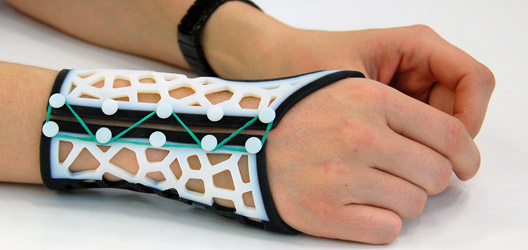A Loughborough University lecturer has developed a computer software concept that will enable clinicians with no experience in Computer Aided Design (CAD) to design and make custom-made 3D printed wrist splints for rheumatoid arthritis sufferers.
Dr Abby Paterson, from the Design School, said: “I wanted to give clinicians the ability to make splints they have not been able to make before.
“They can improve the aesthetics, the fit, and integrate extra bits of functionality they couldn’t do before as a result of our Additive Manufacturing facilities here at Loughborough University.
“Thanks to our Objet Connex machine, we can integrate multiple materials in a single splint such as rubber-like integral hinges or cushioning features but, more importantly, the specialised software prototype we’ve developed will enable clinicians to design these splints for their patients.”
The 3D printed splints are not only more comfortable and attractive but potentially cheaper than the current ones that are ‘ugly, bulky, and can make a patients arm sweat’. As a result patients do not use them as often as they should.
The splints, which provide joint protection, rest, and promote pain relief,could be a major boost for sufferers of rheumatoid arthritis, the second most common type of arthritis in the UK which affects more than 400,000 people.
The splints are made by scanning a patient’s arm in the ‘appropriate position’. A 3D model splint is then designed based on the scan to generate a computer model.
The 3D printer can then produce as many splints as are needed at the touch of a button. They can be any colour, feature multiple materials, have a lattice design to aid ventilation and any type of fastening the patient requires.
The 3D CAD software prototype was shown to certified splinting practitioners, such as occupational therapists and physiotherapists.
Dr Paterson said: “The practitioners were very excited by new, novel ideas to expand the possibilities available to them, such as integrated rubber borders for increased comfort.”
The 3D CAD software prototype is the product of Dr Paterson’s PhD and development work is still needed on the software and materials.
Dr Paterson was supervised during her PhD by Dr Richard Bibb and Dr Ian Campbell. Dr Bibb came up with the idea for bespoke wrist splints in the late 1990’s.
Dr Bibb and Dr Paterson are currently pursuing opportunities to perform a ‘thorough cost analysis’ of providing the service.
Dr Bibb says the 3D splints could be cheaper than the current ones because the design and manufacture stages have been separated.
He believes they will be cost-effective for the NHS while the ‘sky’s the limit’ in the private sector.
Dr Bibb, Reader in Medical Applications of Design in the Design School, said: “We are in the development phase. The research has proved that this is desirable and the clinicians want it. We know there’s lots of potential.”
Dr Paterson and Dr Bibb believe that with some financial backing they could perfect the CAD software within 18 months.
Dr Paterson conducted her PhD research at Loughborough between 2009 and 2012 before becoming a lecturer at the University of Manchester.
She returned to Loughborough in January as a Lecturer in the Design School and has continued to work on the project.
Source: lboro.ac.uk







